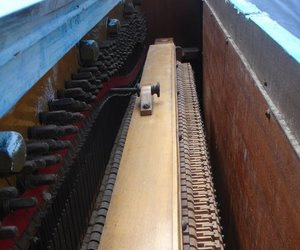 Whether you’re a piano enthusiast, beginner player, or hoping to have a career performing maintenance on these fantastic instruments, it’s important to understand the basic parts of a piano. Every acoustic piano, from older upright to brand new concert grand have certain parts in common. Knowing these can help you understand the instrument more fully, making you a better player.
Whether you’re a piano enthusiast, beginner player, or hoping to have a career performing maintenance on these fantastic instruments, it’s important to understand the basic parts of a piano. Every acoustic piano, from older upright to brand new concert grand have certain parts in common. Knowing these can help you understand the instrument more fully, making you a better player.
Keyboard/Keys
The keyboard is perhaps the most recognizable part of any piano. Each acoustic piano contains a set of up to 88 black and white keys that you press in order to produce the music of the piano. These keys can be made of a variety of materials, though the white keys were once made almost exclusively of ivory.
Hammers & Strings
Each of the keys on a piano keyboard is attached to a small wooden hammer covered in felt. When you press a key, the hammer rises and then falls to strike a string that is tuned to a certain musical note. This is how pianos produce their music. The harder you press a key, the more sharply the hammer will strike the string, and the louder the note will be.
Dampers
In addition to the hammer, a cloth or felt damper also sits over the strings of the piano. When you press the key, both the hammer and damper are raised. When you release the key, the damper falls and mutes the string, which stops it from vibrating past the initial short note. This keeps your notes from blending into one another unintentionally.
Una Corda
The una corda is the left pedal of the piano. It is also known as the soft pedal, as it is used to enhance the sound of notes that are played softly. The pedal either subtly shifts the position of the hammer so that it strikes the piano string in a slightly different way, or moves the hammer closer to the strings. This provides a specific subtle timbre to softly played notes. In an upright piano the latter option is most common, while the former is usually used in grand pianos.
Sustain Pedal
The sustain pedal is the right-hand pedal of the piano, and is also known as the damper pedal. This pedal keeps the dampers lifted off of the strings, allowing them to continue vibrating until the pedal is released. It is most often used for slower, legato music in which the music seems to echo.
Sostenuto Pedal
The sostenuto pedal is usually omitted, except on concert grand pianos. When included, it is located between the una corda and sustain pedals on the piano. This pedal works similarly to the sustain pedal, but can be limited to specific notes rather than all notes played in a passage. This allows legato notes to be played alongside shorter, staccato notes.
